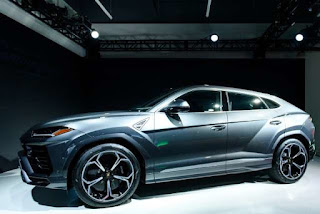The designer behind the Lamborghini Urus SUV uses a special technique to bring his creations to life
Lamborghini showed off its new Urus "super
sport utility vehicle" to media at the Detroit auto
show.
Designer Mitja Borkert also showed off an
interesting design technique.
The Urus is Lambo's bid to get in on the high-end
ute game.
Lamborghini revealed its new Urus SUV to the
US media in Detroit on Monday night, after
earlier showcasing it in Europe.
The Urus is the culmination of a major trend,
kicked off by Porsche over a decade ago with
the Cayenne and more recently pushed
forward by Maserati, Alfa Romero, Jaguar,
and Bentley (and soon, Rolls-Royce): the
luxury SUV from brands that we might have
once though would never do an SUV.
Ferrari is essentially now the only big-name
performance automaker to lack a ute — and
that's going to change in the next few years,
as CEO Sergio Marchionne again stressed in a
press conference in Detroit.
Lamborghini actually built an SUV-ish vehicle
once before, the LM002, a Hummer-like
offroader than was produced for about seven
years in the late 1980s and early 1990s. It's
now regarded as an oddity, and in truth it
doesn't look all that much like a Lamborghini.
The Urus, meanwhile, absolutely does. In an
interview with Business Insider, designer
Mitja Borkert (he joined Lambo in 2016, after
working for Porsche) said that the Urus was
shaped to evoke the sharklike, aggressive,
make-no-mistake-about-it presence of
Lamborghinis such as the iconic Countach
and the current Aventador.
In fact, here's an image of Borkert drawing
the profile of the new SUV.
Except that he isn't "drawing," in the
conventional sense of using a marker or pen
to create his lines. If you look closely, you can
see a small bit of black tape dangling beneath
his right elbow.
That's because he's making a "tape drawing"
of the Urus, to a reduced scale. I first saw
budding car designers do this at Art Center
College of Design in Pasadena, the Harvard or
Oxford of automotive imagination. (I also
watched Borkert draw the old-fashioned way,
with a pencil and paper, while I was chatting
with him).
Tape drawings allow designers to replicate
their designs at scale and engage with them
physically, rather than simply outputting big
digital renderings and sticking to a wall.
Tape also enables the designer to be more
precise at scale than he or she could be if
trying to replicate a drawing.
And tape connects with another unusual car-
design practice: clay models. Remarkably, in
an era when pretty much anything can be
designed digitally, car folks still create
sculpted clay models of new vehicles, right up
to full-size examples. They use tape to
characterize — and refine — the lines.
It's always amazing to me when I see a car
designer using these old, tried-and-true
techniques, even when I know that they can
make full use of the digital tools available to
them.

Comments
Post a Comment